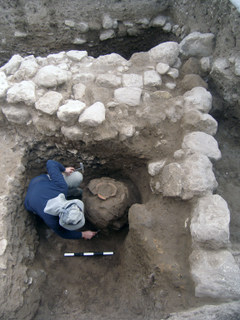Among the rare finds uncovered in the excavation: evidence of a 6,000 year old cultic temple and the first 10,000 year old building to be discovered in the Judean Shephelah
An extensive archaeological excavation of the Israel Antiquities Authority prior to widening Highway 38, which is being underwritten by the Netivei Israel Company, is producing amazing finds that provide a broad picture covering thousands of years of development of human society. Settlement remains were unearthed at the site, the earliest of which dates to the beginning of the eighth millennium BCE and latest to the end of the fourth millennium BCE.
The finds revealed at the site range from the period when man first started to domesticate plants and animals, instead of searching for them in the wild, until the period when we see the beginnings of proper urban planning.
The oldest artifacts that were exposed at the site are ascribed to the Pre-Pottery Neolithic period (10,000 YBP). According to Dr. Amir Golani, Dr. Ya‘akov Vardi, Benyamin Storchan and Dr. Ron Be’eri, excavation directors on behalf of the Israel Antiquities Authority, “This is the first time that such an ancient structure has been discovered in the Judean Shephelah. The building, almost all of which was found, underwent a number of construction and repair phases that allude to its importance. It should be emphasized that whoever built the house did something that was totally innovative because up until this period man migrated from place to place in search of food. Here we have evidence of man’s transition to permanent dwellings and that in fact is the beginning of the domestication of animals and plants; instead of searching out wild sheep, ancient man started raising them near the house”.
A cluster of nine flint and limestone axes that were discovered lying side by side was found near this prehistoric building. “It is apparent that the axes, some of which were used as tools and some as cultic objects, were highly valued by their owners. Just as today we are unable to get along without a cellular telephone and a computer, they too attributed great importance to their tools. Based on how it was arranged at the time of its discovery it seems that the cluster of axes was abandoned by its owner for some unknown reason”.
In the archaeological excavation conducted at Eshta’ol an important and rare find from the end of the Chalcolithic period (second half of the fifth millennium BCE) was discovered in the adjacent area. During the course of the excavation six thousand year old buildings were exposed and a stone column (called a standing stone or mazzevā) was discovered alongside one of them. The standing stone is 1.30 meters high and weighs several hundred kilos. According to the excavation directors, “The standing stone was smoothed and worked on all six of its sides, and was erected with one of its sides facing east. This unique find alludes to the presence of a cultic temple at the site”. The archaeologists said, “In the past numerous manifestations have been found of the cultic practice that existed in the Chalcolithic period; however, from the research we know of only a few temples at ‘En Gedi and at Teleilat Ghassul in Transjordan”.
“We uncovered a multitude of unique finds during the excavation”, says Dr. Amir Golani, one of the excavation directors on behalf of the Israel Antiquities Authority. “The large excavation affords us a broad picture of the progression and development of the society in the settlement throughout the ages. Thus we can clearly see that in the Early Bronze Age, 5,000 years ago, the rural society made the transition to an urban society. We can see distinctly a settlement that gradually became planned, which included alleys and buildings that were extremely impressive from the standpoint of their size and the manner of their construction. We can clearly trace the urban planning and see the guiding hand of the settlement’s leadership that chose to regulate the construction in the crowded regions in the center of the settlement and allowed less planning along its periphery. It is fascinating to see how in such an ancient period a planned settlement was established in which there is orderly construction, and trace the development of the society which became increasingly hierarchical”.

A typical jar of the Early Bronze Age was discovered buried beneath the floor of a building. Photograph: Dr. Ron Be’eri, courtesy of the Israel Antiquities Authority



